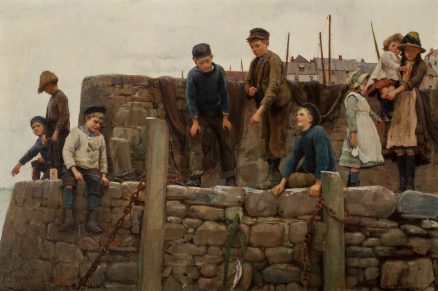Untitled (The Young Fishermen)
, circa 1884Oil on canvas, 23⅞ by 35¾ inches
- Categories
- Children
- Figural works
- Immigrant artists
- Zoom in on Artwork
- Print Page
- Email Page to Friend
Charles E. Boutwood’s charming genre scene presents a motley assortment of children gathered on the shallow ledge of a massive stone pier. Viewed from slightly below as if from a boat on the water’s surface, six sturdy boys are intent on their hand-held fishing lines, one just pulled up to reveal a modest catch that elicits a look of satisfaction from a seated boy in a blue smock. On the right, a girl with a toddler in her arms and a younger girl who seems to turn away shyly are unacknowledged witnesses to the boys’ happy activity. The pier with its rough stained stonework almost fills the composition, which reveals a bit of distant open water on the left. Emerging into view just above the pier are boat masts and a cluster of slate-roofed cottages. A bright but overcast sky provides a contrasting backdrop for several of the figures, its bleached tones echoed in the smock of one of the boys and in the girls’ aprons.
A celebration of carefree youth and traditional life, this painting likely pictures a scene in Polperro, in Cornwall, England, long a favorite setting for the English-born Boutwood. The artist first visited the fishing village in the 1880s, exhibiting several works made there in the Royal Academy of Arts annual exhibition of 1885. Settling in Chicago with his wife, a Polperro native, in 1888, Boutwood returned often, eventually relocating to Polperro permanently. In 1911, when he exhibited several Polperro paintings in the Art Institute of Chicago’s annual exhibition for Chicago artists, the Fine Arts Journal described the artist as “a pretty regular visitor to his native country,” painting works that “present a shore very picturesque with rock formations, and the old fashioned English houses perched about picturesquely. The natives of the country are reproduced with conscientious care in various agreeable groupings.”i If this painting shows Polperro, Boutwood must have taken liberties with the setting, for the steep hills surrounding the village would be unavoidably present in any view of its old houses.
This work was evidently not one of the Polperro works that Boutwood showed in 1911, however. Examples of his paintings of figures out-of-doors in the 1910s demonstrate his absorption of modern artistic trends, notably the sun-saturated color and loose brushwork of impressionism. Such elements are not seen in this work, whose naturalism, dark tones, and narrative interest reflect rather the artist’s academic training in the late 1870s. Indeed, the painting is closely related in style and subject to another Boutwood painting of boys fishing from a pier, dated 1884, which shows virtually the same setting, activity, models, and even costume.ii Untitled (The Young Fishermen) likely also dates to the mid-1880s, predating Boutwood’s arrival in Chicago.
Wendy Greenhouse, PhD
Donated by M. Christine Schwartz to The Richard H. Driehaus Museum, Chicago, Illinois, in 2021
i James William Pattison, “Exhibition of Works by Chicago Artists—Paintings and Sculpture,” Fine Arts Journal 24 (Mar. 1911): 148.
ii Their Happiest Day is reproduced in an advertisement for M. Newman Ltd. of London in The Connoisseur 172 (Nov. 1969): lxxxiv.
